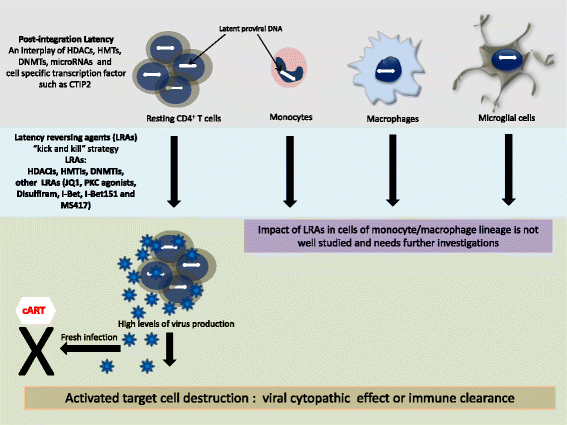Epigenetic control of HIV-1 post integration latency: implications for therapy
- PMID: 26405463
- PMCID: PMC4581042
- DOI: 10.1186/s13148-015-0137-6
Epigenetic control of HIV-1 post integration latency: implications for therapy
Abstract
With the development of effective combined anti-retroviral therapy (cART), there is significant reduction in deaths associated with human immunodeficiency virus type 1 (HIV-1) infection. However, the complete cure of HIV-1 infection is difficult to achieve without the elimination of latent reservoirs which exist in the infected individuals even under cART regimen. These latent reservoirs established during early infection have long life span, include resting CD4(+) T cells, macrophages, central nervous system (CNS) resident macrophage/microglia, and gut-associated lymphoid tissue/macrophages, and can actively produce virus upon interruption of the cART. Several epigenetic and non-epigenetic mechanisms have been implicated in the regulation of viral latency. Epigenetic mechanisms such as histone post translational modifications (e.g., acetylation and methylation) and DNA methylation of the proviral DNA and microRNAs are involved in the establishment of HIV-1 latency. The better understanding of epigenetic mechanisms modulating HIV-1 latency could give clues for the complete eradication of these latent reservoirs. Several latency-reversing agents (LRA) have been found effective in reactivating HIV-1 reservoirs in vitro, ex vivo, and in vivo. Some of these agents target epigenetic modifications to elicit viral expression in order to kill latently infected cells through viral cytopathic effect or host immune response. These therapeutic approaches aimed at achieving a sterilizing cure (elimination of HIV-1 from the human body). In the present review, we will discuss our current understanding of HIV-1 epigenomics and how this information can be moved from the laboratory bench to the patient's bedside.
Keywords: CD4+ T cells; Epigenetics; HIV-1; Histone modifications; Latency; MicroRNAs; Microglia; Monocyte/macrophage.
Figures

References
-
- Global update on HIV treatment 2013: Web page link: http://apps.who.int/iris/bitstream/10665/85326/1/9789241505734_eng.pdf. Accessed 10 September 2015.
Publication types
LinkOut - more resources
Full Text Sources
Other Literature Sources
Research Materials

